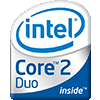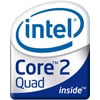
Intel Pentium D 915 vs Intel Pentium E2180
Ultimo aggiornamento:
Confronto con benchmark

|
 |

|
| Intel Pentium D 915 | Intel Pentium E2180 | |
Confronto CPUIntel Pentium D 915 o Intel Pentium E2180 - quale processore è più veloce? In questo confronto guardiamo le differenze e analizziamo quale di queste due CPU è migliore. Confrontiamo i dati tecnici e i risultati dei benchmark.
Il Intel Pentium D 915 ha 2 core con 2 thread e clock con una frequenza massima di 2,80 GHz. Fino a GB di memoria sono supportati in 0 canali di memoria. Il Intel Pentium D 915 è stato rilasciato in Q3/2006. Il Intel Pentium E2180 ha 2 core con 2 thread e clock con una frequenza massima di 2,00 GHz. La CPU supporta fino a 16 GB di memoria in 2 canali di memoria. Il Intel Pentium E2180 è stato rilasciato in Q3/2007. |
||
| Intel Pentium (150) | Famiglia | Intel Pentium (150) |
| Intel Pentium D (6) | Gruppo CPU | Intel Pentium D (6) |
| 0 | Generazione | 0 |
| Presler | Architettura | Presler |
| Desktop / Server | Segmento | Desktop / Server |
| -- | Predecessore | -- |
| -- | Successore | -- |
|
|
||
CPU Cores e frequenza di baseIntel Pentium D 915 ha 2 core CPU e può calcolare 2 thread in parallelo. La frequenza di clock di Intel Pentium D 915 è 2,80 GHz mentre Intel Pentium E2180 ha 2 core CPU e 2 thread possono calcolare simultaneamente. La frequenza di clock di Intel Pentium E2180 è al 2,00 GHz. |
||
| Intel Pentium D 915 | Caratteristica | Intel Pentium E2180 |
| 2 | Cores | 2 |
| 2 | Threads | 2 |
| normal | Architettura principale | normal |
| No | Hyperthreading | No |
| No | Overclocking ? | Si |
| 2,80 GHz | Frequenza | 2,00 GHz |
| -- | Turbo Frequenza (1 Core ) | -- |
| -- | Turbo Frequenza (Tutti Cores) | -- |
Memoria & PCIeIntel Pentium D 915 può utilizzare fino a GB di memoria in 0 canali di memoria. La larghezza di banda massima della memoria è --. Intel Pentium E2180 supporta fino a 16 GB di memoria in 2 canali di memoria e raggiunge una larghezza di banda di memoria fino a 17,1 GB/s. |
||
| Intel Pentium D 915 | Caratteristica | Intel Pentium E2180 |
| DDR2 | Memoria | DDR3-1066, DDR2-800 |
| Max. Memoria | 16 GB | |
| 0 | Canali di memoria | 2 (Dual Channel) |
| -- | Max. Larghezza di banda | 17,1 GB/s |
| No | ECC | No |
| 4,00 MB | L2 Cache | 1,00 MB |
| -- | L3 Cache | -- |
| -- | Versione PCIe | -- |
| -- | Linee PCIe | -- |
| -- | PCIe Larghezza di banda | -- |
Gestione termicaLa potenza di progettazione termica (TDP in breve) di Intel Pentium D 915 è 95 W, mentre Intel Pentium E2180 ha un TDP di 65 W. Il TDP specifica la soluzione di raffreddamento necessaria per raffreddare sufficientemente il processore. |
||
| Intel Pentium D 915 | Caratteristica | Intel Pentium E2180 |
| 95 W | TDP (PL1 / PBP) | 65 W |
| -- | TDP (PL2) | -- |
| -- | TDP up | -- |
| -- | TDP down | -- |
| -- | Tjunction max. | -- |
Dettagli tecniciIntel Pentium D 915 è prodotto in 65 nm e ha 4,00 MB di cache. Il Intel Pentium E2180 è prodotto in 65 nm e ha una cache di 1,00 MB. |
||
| Intel Pentium D 915 | Caratteristica | Intel Pentium E2180 |
| 65 nm | Tecnologia | 65 nm |
| Monolitico | Design a chip | Monolitico |
| x86-64 (64 bit) | Set di istruzioni (ISA) | x86-64 (64 bit) |
| -- | Estensioni ISA | -- |
| LGA 775 | Presa | LGA 775 |
| Nessuno | Virtualizzazione | Nessuno |
| No | AES-NI | No |
| Windows 10, Linux | Sistemi operativi | Windows 10, Linux |
| Q3/2006 | Data di lancio | Q3/2007 |
| 74 $ | Prezzo di rilascio | -- |
| mostra più dati | mostra più dati | |
Valuta questi processori
Performance media nei benchmark
⌀ Prestazioni single core in 1 benchmark CPU
⌀ Prestazioni multi-core in 2 benchmark CPU
Geekbench 5, 64bit (Single-Core)
Geekbench 5 è un benchmark multi-piattaforma che usa in modo intensivo la memoria del sistema.Il test single-core utilizza solo un nucleo elaborativo della CPU. A tal fine, il numero di nuclei elaborativi o la capacità di hyperthreading non sono rilevanti.
|
|
Intel Pentium D 915
2C 2T @ 2,80 GHz |
||
|
|
Intel Pentium E2180
2C 2T @ 2,00 GHz |
||
Geekbench 5, 64bit (Multi-Core)
Geekbench 5 è un benchmark multi-piattaforma che usa in modo intensivo la memoria del sistema.Il test multi-core coinvolge tutti i nuclei elaborativi della CPU e si avvale del hyperthreading.
|
|
Intel Pentium D 915
2C 2T @ 2,80 GHz |
||
|
|
Intel Pentium E2180
2C 2T @ 2,00 GHz |
||
Risultati stimati da PassMark CPU Mark
Alcune delle CPU elencate di seguito sono stati sottoposti a benchmarking da CPU-monkey. Tuttavia, la maggior parte delle CPU non sono state testate e i risultati sono stati stimati utilizzando una formula segreta di proprietà di CPU-monkey. Come tali, essi non riflettono con precisione i valori attuali di Passmark CPU Mark e non sono stati approvati da PAssMark Software Pty Ltd.
|
|
Intel Pentium D 915
2C 2T @ 2,80 GHz |
||
|
|
Intel Pentium E2180
2C 2T @ 2,00 GHz |
||
Cinebench R23 (Single-Core)
Cinebench R23 è il successore di Cinebench R20 ed è anch'esso basato su Cinema 4D. Cinema 4D è un software usato a livello mondiale per creare forme in 3D. Il test single-core utilizza solo un nucleo elaborativo della CPU. A tal fine, il numero di nuclei elaborativi o la capacità di hyperthreading non sono rilevanti.
|
|
Intel Pentium D 915
2C 2T @ 2,80 GHz |
||
|
|
Intel Pentium E2180
2C 2T @ 2,00 GHz |
||
Cinebench R23 (Multi-Core)
Cinebench R23 è il successore di Cinebench R20 ed è anch'esso basato su Cinema 4D. Cinema 4D è un software usato a livello mondiale per creare forme in 3D. Il test multi-core coinvolge tutti i nuclei elaborativi della CPU e si avvale del hyperthreading.
|
|
Intel Pentium D 915
2C 2T @ 2,80 GHz |
||
|
|
Intel Pentium E2180
2C 2T @ 2,00 GHz |
||
Geekbench 6 (Single-Core)
Geekbench 6 è un punto di riferimento per computer, notebook e smartphone moderni. Ciò che è nuovo è un utilizzo ottimizzato delle architetture CPU più recenti, ad esempio basate sul concetto big.LITTLE e combinando core CPU di diverse dimensioni. Il benchmark single-core valuta solo le prestazioni del core della CPU più veloce, il numero di core della CPU in un processore è irrilevante qui.
|
|
Intel Pentium D 915
2C 2T @ 2,80 GHz |
||
|
|
Intel Pentium E2180
2C 2T @ 2,00 GHz |
||
Geekbench 6 (Multi-Core)
Geekbench 6 è un punto di riferimento per computer, notebook e smartphone moderni. Ciò che è nuovo è un utilizzo ottimizzato delle architetture CPU più recenti, ad esempio basate sul concetto big.LITTLE e combinando core CPU di diverse dimensioni. Il benchmark multi-core valuta le prestazioni di tutti i core della CPU del processore. I miglioramenti del thread virtuale come AMD SMT o l'Hyper-Threading di Intel hanno un impatto positivo sul risultato del benchmark.
|
|
Intel Pentium D 915
2C 2T @ 2,80 GHz |
||
|
|
Intel Pentium E2180
2C 2T @ 2,00 GHz |
||
Cinebench R20 (Single-Core)
Cinebench R20 è il successore di Cinebench R15 ed è anch'esso basato su Cinema 4D. Cinema 4D è un software usato a livello mondiale per creare forme in 3D. Il test single-core utilizza solo un nucleo elaborativo della CPU. A tal fine, il numero di nuclei elaborativi o la capacità di hyperthreading non sono rilevanti.
|
|
Intel Pentium D 915
2C 2T @ 2,80 GHz |
||
|
|
Intel Pentium E2180
2C 2T @ 2,00 GHz |
||
Cinebench R20 (Multi-Core)
Cinebench R20 è il successore di Cinebench R15 ed è anch'esso basato su Cinema 4D. Cinema 4D è un software usato a livello mondiale per creare forme in 3D. Il test multi-core coinvolge tutti i nuclei elaborativi della CPU e si avvale del hyperthreading.
|
|
Intel Pentium D 915
2C 2T @ 2,80 GHz |
||
|
|
Intel Pentium E2180
2C 2T @ 2,00 GHz |
||
CPU-Z Benchmark 17 (Multi-Core)
Il benchmark CPU-Z misura le prestazioni di un processore misurando il tempo impiegato dal sistema per completare tutti i calcoli del benchmark. Più velocemente viene completato il benchmark, maggiore è il punteggio.
|
|
Intel Pentium D 915
2C 2T @ 2,80 GHz |
||
|
|
Intel Pentium E2180
2C 2T @ 2,00 GHz |
||
Cinebench R15 (Single-Core)
Cinebench R15 è il successore di Cinebench 11.5 ed è anch'esso basato su Cinema 4D. Cinema 4D è un software usato a livello mondiale per creare forme in 3D. Il test single-core utilizza solo un nucleo elaborativo della CPU. A tal fine, il numero di nuclei elaborativi o la capacità di hyperthreading non sono rilevanti.
|
|
Intel Pentium D 915
2C 2T @ 2,80 GHz |
||
|
|
Intel Pentium E2180
2C 2T @ 2,00 GHz |
||
Cinebench R15 (Multi-Core)
Cinebench R15 è il successore di Cinebench 11.5 ed è anch'esso basato su Cinema 4D. Cinema 4D è un software usato a livello mondiale per creare forme in 3D. Il test multi-core coinvolge tutti i nuclei elaborativi della CPU e si avvale del hyperthreading.
|
|
Intel Pentium D 915
2C 2T @ 2,80 GHz |
||
|
|
Intel Pentium E2180
2C 2T @ 2,00 GHz |
||
Dispositivi che utilizzano questo processore |
|
| Intel Pentium D 915 | Intel Pentium E2180 |
| Sconosciuto | Sconosciuto |
I confronti più popolari che contengono questa CPU
Torna all'indice







